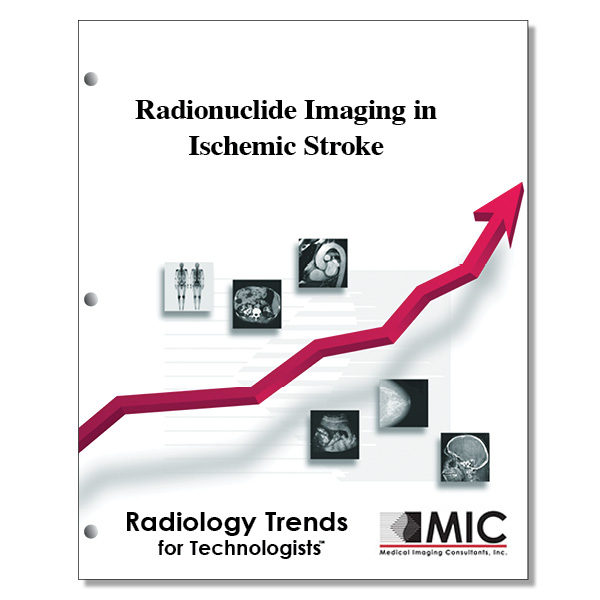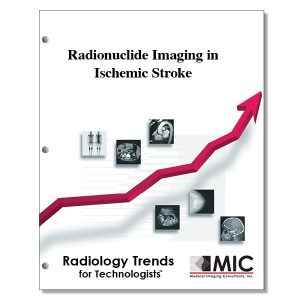

Radionuclide Imaging in Ischemic Stroke
Radioactive tracers and applications of radioisotope studies in stroke evaluation are presented. Future perspectives using hybrid imaging are discussed.
Course ID: Q00423 Category: Radiology Trends for Technologists Modalities: Nuclear Medicine, PET2.75 |
Satisfaction Guarantee |
$29.00
- Targeted CE
- Outline
- Objectives
Targeted CE per ARRT’s Discipline, Category, and Subcategory classification for enrollments starting after February 24, 2023:
[Note: Discipline-specific Targeted CE credits may be less than the total Category A credits approved for this course.]
Computed Tomography: 0.50
Procedures: 0.50
Head, Spine, and Musculoskeletal: 0.50
Magnetic Resonance Imaging: 0.50
Procedures: 0.50
Neurological: 0.50
Nuclear Medicine Technology: 2.25
Procedures: 2.25
Other Imaging Procedures: 2.25
Registered Radiologist Assistant: 1.00
Procedures: 1.00
Neurological, Vascular, and Lymphatic Sections: 1.00
Outline
- Introduction
- Physiologic Variables Affected in Ischemic Stroke
- Radioactive Tracers Used in Stroke
- Applications of Radioisotope Studies in Stroke
- Detection of Ischemic Lesion
- Identification of the Ischemic Penumbra
- Noninvasive Imaging of the Penumbra
- Radioisotope Imaging as a Surrogate Marker for Treatment Efficiency and for Selection of Patients for Special Therapeutic Strategies
- Microglial Activation as an Indicator of Inflammation
- Hemodynamic and Metabolic Reserve in Arterial Occlusive Disease
- Deactivation of Remote Tissue (Diaschisis
- Activation Studies in Stroke Patients
- Conclusion and Future Perspectives
Objectives
Upon completion of this course, students will:
- define the term malignant as it applies to brain infarction
- identify the gas used in the first quantitative method of measuring CBF
- list the radioactive gases used for imaging studies of rCBF
- describe the xenon method of rCBF measurement
- describe the percentage of total basal oxygen consumption used by the brain
- list the vascular components of the CBV
- describe the average CBF to the gray matter
- describe the percentage of total-body glucose consumption used by the brain at rest
- indicate the brain-tissue partial oxygen pressure at which loss of consciousness occurs
- describe the time it takes for loss of consciousness to occur following stoppage of CBF
- list the characteristics of SPECT radiopharmaceuticals used for stroke evaluation
- list the SPECT radiopharmaceuticals used for imaging of CBF
- list the isotopes used in PET radiopharmaceuticals for stroke evaluation
- list the PET radiopharmaceuticals used for measuring CBF
- describe the final structure of the PET radiopharmaceutical used for evaluation of glucose metabolism
- identify the imaging modalities that produce morphologic images for coregistration with SPECT imaging
- compare the sensitivities of SPECT, PET and CT for detection of the presence and extent of stroke
- describe the effect of SPECT imaging on neurologic deficit scores
- indicate the level of decreased perfusion in brain tissue that represents the flow threshold for reversible functional failure
- identify the region of the brain with the potential for functional recovery without morphologic damage following acute ischemic stroke
- list the three regions within a disturbed vascular territory that can be classified by PET
- describe the difficulties with using SPECT perfusion studies in identifying hypoperfused tissue that is amenable to reperfusion therapy
- list the radiopharmaceuticals used for PET imaging of the ischemic penumbra
- compare the accuracies of MR DWI and PWI in identifying the ischemic penumbra and predicting infarcted tissue
- describe the use of the PET radiopharmaceutical 18F-fluoromisonidazole
- identify the radiopharmaceutical used to generate a penumbagram
- describe the limitations of 18F-fluoromisonidazole evaluation of the ischemic penumbra
- identify the vessel territory associated with malignant brain infarcts in 10% of patients
- be familiar with the proposed stages of hemodynamic compromise
- list the imaging techniques that can identify selective neuronal loss in the cortex resulting from exhausted metabolic reserve
- describe the brain regions that demonstrate significant reductions of CBF and metabolism following Infarct of the parietal and frontal lobes
- indicate the brain region most frequently affected by post-stroke aphasia in right-handed individuals with left hemispheric language dominance
- identify the best method for imaging the morphology of the brain in health and disease
- describe the advanced MR imaging technique used to evaluate the concentrations of defined substrates and chemicals
- identify the PET radiopharmaceutical that is part of an innovative strategy for imaging evaluation of angiogenesis
